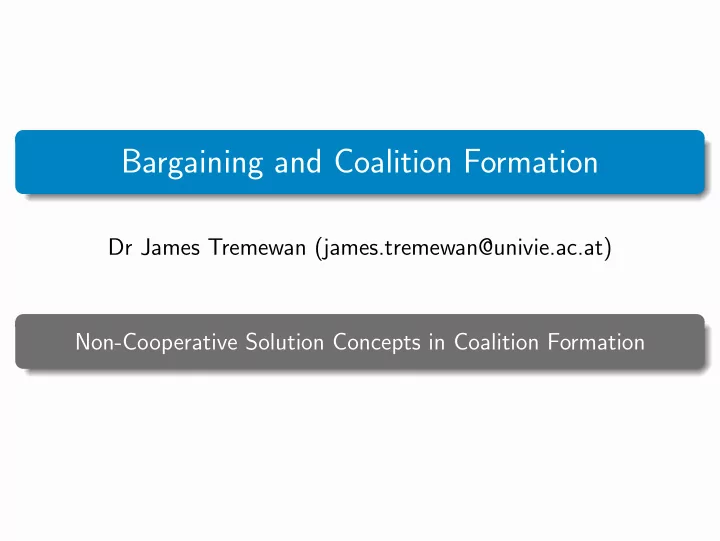

Bargaining and Coalition Formation Dr James Tremewan (james.tremewan@univie.ac.at) Non-Cooperative Solution Concepts in Coalition Formation
Non-Cooperative Solution Concepts Nash Equilibrium • The standard solution concept in non-cooperative game theory is Nash equilibrium. 1 Can also be used in coalition formation games. • NE consider an outcome (or agreement) stable (or self-enforcing ), if no individual can improve their payoff taking other players’ strategies as given. • Appropriate in a context with no pre-game communication, but in a coalition formation context it is natural to think that players can communicate. • The following solution concepts are for situations where pre-play communication is possible, but commitment is not (differentiating from cooperative solution concepts). Agreements must still be self-enforcing. 1 We will only be looking at static games of full information. 2/8
Non-Cooperative Solution Concepts Strong Nash Equilibrium • SNE (Aumann, 1959) consider an outcome self-enforcing if no coalition can improve the payoff of all its members taking other players’ strategies as given. 2 • Clearly all SNE are NE (individuals are coalitions of size one). • All SNE are Pareto efficient... why? • Incorporates the idea that a group of players can discuss strategies and simultaneously deviate, but very strong requirement and often no SNE exists. • e.g. Prisoners’ Dilemma: • Unique NE: both players defect. • Not a SNE as the grand coalition can deviate to both cooperate, and both players gain. • Sometimes SNE don’t seem reasonable as they must be robust to deviations to outcomes which themselves are not stable: would a coalition deviate to an outcome that is not stable? 2 See Bernheim et al. (1987) for formal definition. 3/8
Non-Cooperative Solution Concepts Coalition-Proof Nash Equilibrium • CPNE assume players are farsighted rather than myopic . • CPNE (Bernheim et al, 1987) consider an agreement self-enforcing if no coalition can form a self-enforcing agreement that improves the payoff of all its members taking other players’ strategies as given. However only deviations by sub-coalitions of the originally deviating coalition are considered. • Bernheim et al justify restricting the future deviations considered to those of a subset of coalitions by appealing to information problems: players within the deviating coalition will have information (about earlier deviations) that those outside do not, making it hard to form agreements between insiders and outsiders. • Presumably this restriction is for tractability, but could make sense in some contexts, e.g. coalition gaining independence for South Sudan now breaking down into sub-coalitions to fight over newly won resources. 4/8
Non-Cooperative Solution Concepts Coalition-Proof Nash Equilibrium • CPNE is less stringent requirement than SNE: clearly all SNE are CPNE (and all CPNE are NE). • Prisoners dilemma: both players defect is a CPNE... the deviation that prevented it from being a SNE is to an unstable agreement: the grand coalition can deviate to both cooperate but then either member of that coalition can unilaterally deviate further to improve their payoff. • There exist games with no CPNE. • Bernheim et al extend the idea to games in extensive form. • The authors also argue that CPNE can be more intuitive than Pareto dominance refinement (considering only Pareto efficient NE): example on next slide. 5/8
Non-Cooperative Solution Concepts Coalition-Proof Nash Equilibrium: 3-Player Game C 1 C 2 B 1 B 2 B 1 B 2 1,1,-5 -5,-5,0 -1,-1,5 -5,-5,0 A 1 A 1 A 2 -5,-5,0 0,0,10 A 1 -5,-5,0 -2,-2,0 • Two NE: ( A 2 , B 2 , C 1 ) and ( A 1 , B 1 , C 2 ). • The first Pareto dominates the second so would be chosen by Pareto dominance refinement. • But from ( A 2 , B 2 , C 1 ) A and B have an incentive to jointly deviate to ( A 1 , B 1 , C 1 ), and this deviation is self-enforcing (no further deviation by A or B could improve their payoffs). Thus ( A 1 , B 1 , C 2 ) is the only CPNE. • There is no SNE as SNE ⊂ CPNE and ( A 1 , B 1 , C 2 ) is not Pareto efficient. 6/8
Non-Cooperative Solution Concepts The Largest Consistent Set • Chwe (1994) identifies two issues with CPNE: • It is not always reasonable to restrict consideration to future deviations by sub-coalitions. • Far-sighted coalitions may want deviate to agreements that are initially worse for them but will be followed by a future deviation that benefits them. • The LCS is a solution concept that incorporates the above two points: • Potential deviations are only considered if they are stable with respect to future chains of deviations involving any combination of coalitions which may consist of any players. • Coalitions may consider deviating to agreements that make them worse off as long as they will end up better off after some chain of deviations. • The LCS is intentionally a ”weak” concept: rather than looking for stable outcomes, it eliminates outcomes that are definitely not stable, so may not make precise prediction. 7/8
Non-Cooperative Solution Concepts Overview • We have seen a range of solution concepts which can be used to analyse non-cooperative games in contexts where it is reasonable to assume that players may communicate, but are unable to commit so that agreements are only stable if they are in some sense self-enforcing. • As with cooperative solution concepts we face a trade-off: more restrictive solution concepts make tighter predictions, but may not aways exist. • Also, the assumptions underlying a solution concept may be more or less appropriate in a particular context: • Players may be genuinely myopic (i.e. SNE prefered to CPNE). • Private information by deviating players may be important (i.e. CPNE preferred to LCS). 8/8
Recommend
More recommend